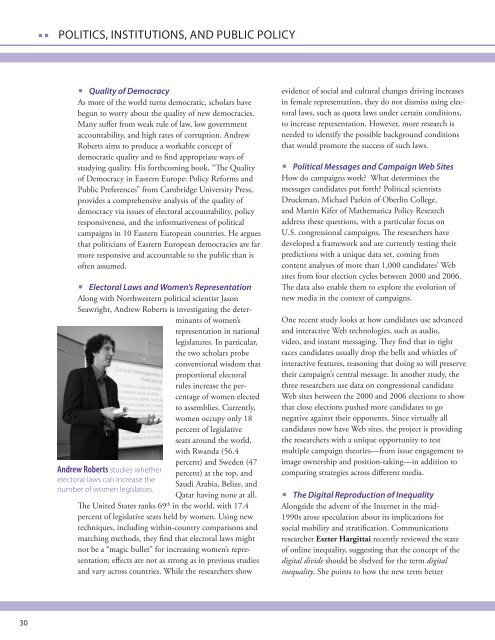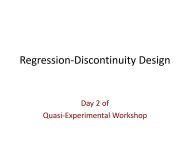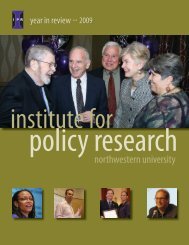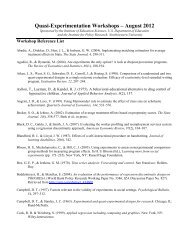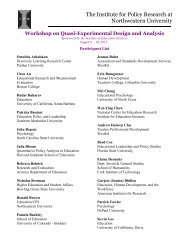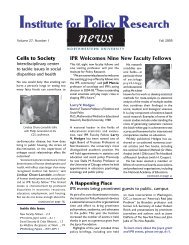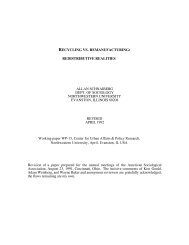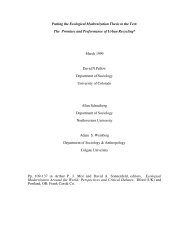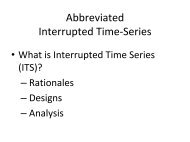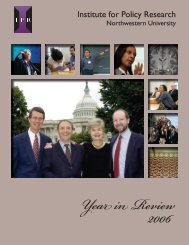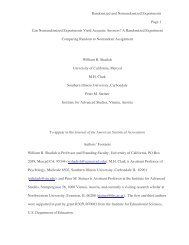IPR - Institute for Policy Research - Northwestern University
IPR - Institute for Policy Research - Northwestern University
IPR - Institute for Policy Research - Northwestern University
You also want an ePaper? Increase the reach of your titles
YUMPU automatically turns print PDFs into web optimized ePapers that Google loves.
Politics, Institutions, and Public <strong>Policy</strong><br />
< Quality of Democracy<br />
As more of the world turns democratic, scholars have<br />
begun to worry about the quality of new democracies.<br />
Many suffer from weak rule of law, low government<br />
accountability, and high rates of corruption. Andrew<br />
Roberts aims to produce a workable concept of<br />
democratic quality and to find appropriate ways of<br />
studying quality. His <strong>for</strong>thcoming book, “The Quality<br />
of Democracy in Eastern Europe: <strong>Policy</strong> Re<strong>for</strong>ms and<br />
Public Preferences” from Cambridge <strong>University</strong> Press,<br />
provides a comprehensive analysis of the quality of<br />
democracy via issues of electoral accountability, policy<br />
responsiveness, and the in<strong>for</strong>mativeness of political<br />
campaigns in 10 Eastern European countries. He argues<br />
that politicians of Eastern European democracies are far<br />
more responsive and accountable to the public than is<br />
often assumed.<br />
< Electoral Laws and Women’s Representation<br />
Along with <strong>Northwestern</strong> political scientist Jason<br />
Seawright, Andrew Roberts is investigating the determinants<br />
of women’s<br />
representation in national<br />
legislatures. In particular,<br />
the two scholars probe<br />
conventional wisdom that<br />
proportional electoral<br />
rules increase the percentage<br />
of women elected<br />
to assemblies. Currently,<br />
women occupy only 18<br />
percent of legislative<br />
seats around the world,<br />
with Rwanda (56.4<br />
percent) and Sweden (47<br />
Andrew Roberts studies whether percent) at the top, and<br />
electoral laws can increase the<br />
Saudi Arabia, Belize, and<br />
number of women legislators.<br />
Qatar having none at all.<br />
The United States ranks 69 th in the world, with 17.4<br />
percent of legislative seats held by women. Using new<br />
techniques, including within-country comparisons and<br />
matching methods, they find that electoral laws might<br />
not be a “magic bullet” <strong>for</strong> increasing women’s representation;<br />
effects are not as strong as in previous studies<br />
and vary across countries. While the researchers show<br />
evidence of social and cultural changes driving increases<br />
in female representation, they do not dismiss using electoral<br />
laws, such as quota laws under certain conditions,<br />
to increase representation. However, more research is<br />
needed to identify the possible background conditions<br />
that would promote the success of such laws.<br />
< Political Messages and Campaign Web Sites<br />
How do campaigns work? What determines the<br />
messages candidates put <strong>for</strong>th? Political scientists<br />
Druckman, Michael Parkin of Oberlin College,<br />
and Martin Kifer of Mathematica <strong>Policy</strong> <strong>Research</strong><br />
address these questions, with a particular focus on<br />
U.S. congressional campaigns. The researchers have<br />
developed a framework and are currently testing their<br />
predictions with a unique data set, coming from<br />
content analyses of more than 1,000 candidates’ Web<br />
sites from four election cycles between 2000 and 2006.<br />
The data also enable them to explore the evolution of<br />
new media in the context of campaigns.<br />
One recent study looks at how candidates use advanced<br />
and interactive Web technologies, such as audio,<br />
video, and instant messaging. They find that in tight<br />
races candidates usually drop the bells and whistles of<br />
interactive features, reasoning that doing so will preserve<br />
their campaign’s central message. In another study, the<br />
three researchers use data on congressional candidate<br />
Web sites between the 2000 and 2006 elections to show<br />
that close elections pushed more candidates to go<br />
negative against their opponents. Since virtually all<br />
candidates now have Web sites, the project is providing<br />
the researchers with a unique opportunity to test<br />
multiple campaign theories—from issue engagement to<br />
image ownership and position-taking—in addition to<br />
comparing strategies across different media.<br />
< The Digital Reproduction of Inequality<br />
Alongside the advent of the Internet in the mid-<br />
1990s arose speculation about its implications <strong>for</strong><br />
social mobility and stratification. Communications<br />
researcher Eszter Hargittai recently reviewed the state<br />
of online inequality, suggesting that the concept of the<br />
digital divide should be shelved <strong>for</strong> the term digital<br />
inequality. She points to how the new term better<br />
30


